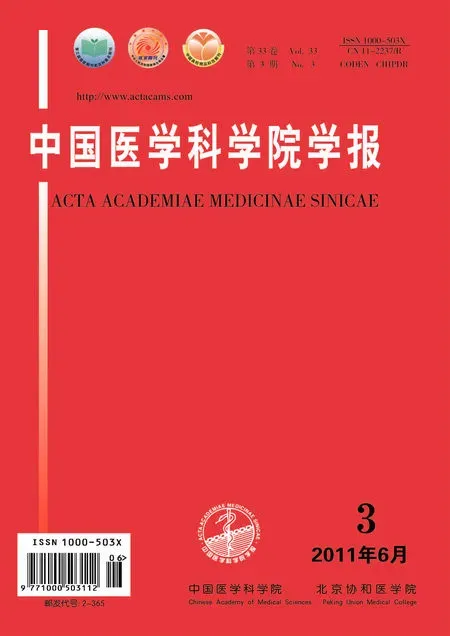重度肥胖患者脂肪体积与人体测量参数的相关性
王 萱,薛华丹,康维明,于健春,金征宇
中国医学科学院 北京协和医学院 北京协和医院 1放射科 2基本外科,北京 100730
·减重、糖尿病手术及综合治疗论坛论著·
重度肥胖患者脂肪体积与人体测量参数的相关性
王 萱1,薛华丹1,康维明2,于健春2,金征宇1
中国医学科学院 北京协和医学院 北京协和医院1放射科2基本外科,北京 100730
目的研究重度肥胖患者脂肪体积与人体测量参数的相关性。方法以14例重度肥胖患者为研究对象,行多层螺旋CT扫描,采用Volume软件评价患者全身脂肪体积和内脏脂肪体积,测量脐平面内脏脂肪体积、皮下脂肪体积和总脂肪体积,研究各参数与体重、体重指数(BMI)和腰围间的相关性。结果所有扫描均成功进行。全身脂肪体积与体重(r=0.7185,P=0.004)、BMI(r=0.8079,P=0.004)和腰围(r=0.7627,P=0.002)均呈显著正相关;内脏脂肪体积与体重(r=0.5727,P=0.032)和腰围呈显著正相关(r=0.6707,P=0.001)。全身脂肪体积与脐平面皮下脂肪体积呈显著正相关(r=0.8926,P=0.000),内脏脂肪体积与脐平面内脏脂肪体积呈显著正相关 (r=0.5949,P=0.025)。结论多层螺旋CT可用于评估重度肥胖患者全身及腹部脂肪分布。腰围与内脏脂肪体积显著相关,可用于简易衡量脂肪在腹部的分布。
肥胖;X线计算机,体层摄影术;全身脂肪;内脏脂肪;人体测量;腰围
超重和肥胖是代谢综合征及心血管疾病等的重要危险因素。有研究表明,当体重指数(body mass index,BMI)大于25.0 kg/m2时,死亡风险增加;当BMI超过30.0 kg/m2时,死亡风险则显著上升[1]。与皮下脂肪相比,内脏脂肪具有不同的代谢活性,被认为是压力相关、具有潜在代谢活性的内分泌器官。内脏脂肪增多是2型糖尿病的独立危险因素[2],而中心性肥胖患者的全因死亡风险更大[3]。此外,内脏脂肪对于饮食、运动及药物等减重手段更加敏感[4-7]。因此,评估胃减容术前肥胖患者的全身及内脏脂肪分布具有实际的临床意义。本研究采用多层螺旋CT,评估了重度肥胖患者脂肪体积与人体测量参数的相关性,以期为今后的临床应用提供帮助。
对象和方法
对象2009年9月至2011年1月在北京协和医院住院拟行腹腔镜下可调节胃束带术(laparoscopic adjustable gastric banding,LAGB)肥胖症患者14例,所有患者BMI均大于等于35.0 kg/m2,符合国人重度肥胖标准[8]。其中,男5例,女9例,平均年龄(30.1±9.3)岁(21~56岁),平均体重(129.3±24.9)kg(97.0~172.0 kg),平均BMI(44.8±7.1)kg/m2(35.1~56.0 kg/m2)。
扫描方案采用西门子双源CT (Somatom Definition,Siemens Medical Solutions,Forchheim, Germany)进行扫描。先行定位像,再行平扫扫描,扫描方向为头至足。患者取仰卧位,一手臂放于胸前,另一手臂抱头。在躯干部扫描时嘱患者屏气。扫描参数:准直器宽度64×0.6 mm,机架旋转时间0.33 s。扫描长度1980 mm,螺距因子1.4,管电压120 kVp,管电流20 mAs,视野50 cm×50 cm。重建层厚7 mm,重建层间距7 mm。卷积核值D30f。记录仪器自动生成的剂量长度乘积(dose length product,DLP)报告值,有效放射剂量=DLP×转化系数 [k成人(腹盆部)=0.015 mSv/(mGy×cm)]。
数据测量及记录方法采用西门子公司Volume软件对重建后的轴位图像进行处理。在包含了从膈顶到骨盆出口的层面上,逐层用点圈法勾勒腹壁内轮廓。设定体积测定的CT值区间,轮廓线内CT值为-200 Hu至-50 Hu的所有像素列入内脏脂肪组织(visceral adipose tissue,VAT)体积计算范围。同理,在全部轴位图像上,绘制大于体表轮廓的感兴趣区,设定CT值,获得全身脂肪组织(total adipose tissue,TAT)体积。在平脐层面上,获得该层面内脏脂肪体积、皮下脂肪体积和总脂肪体积。
统计学处理采用SAS 8.02统计软件,计量资料以均数±标准差表示,对各变量进行正态性检验,在检验两变量间关系时,如数据符合正态分布,采用Pearson两变量直线相关分析,P<0.05为差异有统计学意义。
结 果
总体数据描述性统计所有扫描均成功进行。14例重度肥胖患者平均全身脂肪体积为(61.8±16.5)L,平均腹部内脏脂肪体积为(5.3±1.7)L,脐平面平均内脏、皮下和总脂肪体积分别为(113±42)、(388±119)和(501±125)cm3。平均腰围为(123±12)cm。上述数据及体重、BMI均符合正态分布。
总体脂肪体积与人体测量参数关系全身脂肪体积与体重(r=0.7185,P=0.004)、BMI(r=0.8079,P=0.004)和腰围(r=0.7627,P=0.002)呈显著正相关;内脏脂肪体积与体重(r=0.5727,P=0.032)和腰围呈显著正相关(r=0.6707,P=0.001),与BMI无相关性(r=0.4986,P=0.070)。
总体脂肪体积与脐平面脂肪体积关系全身脂肪体积与脐平面皮下脂肪体积(r=0.8926,P=0.000)及脐平面总脂肪体积(r=0.8342,P=0.000)呈显著正相关。全腹内脏脂肪体积与脐平面内脏脂肪体积也呈显著正相关(r=0.5949,P=0.025)。
放射剂量DLP报告值为(284.2±25.6)mGy·cm,对应吸收剂量为(4.26±0.38)mSv。
讨 论
肥胖是体内脂肪过度蓄积的状态。近年来,腹部脂肪这一概念日益引起人们的重视。腹部脂肪组织也称为内脏脂肪组织,一般指在腹内包绕胃、肝、肠道、肾脏等脏器的脂肪组织。与皮下脂肪组织和骨骼肌间脂肪组织的生理特性有所不同,腹部脂肪的代谢活性更高,能够分泌一系列细胞因子,如肿瘤坏死因子,白细胞介素6等,它们能够抑制胰岛素受体的信号传递,阻滞胰岛素活性。因此,腹部脂肪过剩所对应的中心性肥胖(也称腹型肥胖),与心血管疾病、高血压、高血糖及血脂紊乱的发生密切相关。研究表明,如果成年女性腹内脂肪面积大于110 cm2,则代谢紊乱的发生率明显提高[9]。
目前临床上脂肪成分的测量方法有多种,其中,生物电阻抗分析精确性差,多用于群体研究,不适于个体随访;双能X线吸收法较为敏感,但受被试者条件影响明显,对于较高体脂含量的个体,双能X线会高估脂肪含量或有明显偏差[10-12]。CT和磁共振成像(magnetic resounce imaging, MRI)是迄今为止评价脂肪分布最准确的方法之一[13-18]。但是,就当前主流机型而言,MRI的扫描孔内径和最大承重都明显小于CT。重度肥胖患者多难以进入MRI扫描孔中,即使进入,幽闭恐惧症的发生率也明显增高[19]。因此,本研究采用CT扫描来评估重度肥胖患者的体脂含量。本研究中CT机型的扫描孔内径为78cm,最大承重为220kg,能够满足实际需要。扫描时采用一手臂放于胸前,另一手臂抱头的仰卧体位,使得双侧肩臂部能包含于扫描野内。对于身高超过175cm的患者,使患者轻度屈膝,以避免扫描长度超出范围。在参数选择上,本研究采用大螺距、低管电流的扫描方案,以降低扫描剂量。在计算吸收剂量时,面对全身各个部位对应的吸收系数不同这一问题,本研究选择了最高的系数因子(腹盆部)计算。实际上,上下肢CT的剂量明显小于躯干部[20]。此外,肥胖患者皮下脂肪蓄积明显,相应内脏结构X线的吸收剂量也会降低。因此,实际的吸收剂量应较理论计算值更低。
横断面扫描评估脂肪含量包括多层和单层扫描两种方法。多层扫描最为准确,不过数据量大,扫描和分析时间较长。单层扫描一般在脐平面或L4、L5 层面扫描,在对正常体型的个体研究中,单层与多层扫描明显相关[16-18]。本研究提示,对于重度肥胖的患者,也可以用单层皮下脂肪体积来评估全身脂肪。在腹部脂肪组织体积的评估上,重度肥胖患者单层扫描的结果与多层扫描具有中等相关性,同时腰围与腹部脂肪也具有显著相关性,提示这两种指标可以帮助判断重度肥胖患者的腹部脂肪沉积。这两种指标较为简单、方便,利于临床应用。分析两指标的相关性均为中等的原因,可能在于腰围受皮下脂肪沉积的影响,而单层面的腹部脂肪体积受实质脏器位置的影响较大,且均没有反映个体的身长差异。
本研究的意义在于,采用多层螺旋CT扫描探讨了重度肥胖患者的脂肪分布与人体测量参数的相关性,以往此类对于脂肪分布的研究多针对于一般人群[21-22]。本研究的局限性在于研究例数较少,没有分组研究性别及年龄等生理因素对于脂肪分布的影响。已有研究表明,腹部脂肪对于药物、饮食干预及运动有较高的反应[4-7]。对于LAGB的反应,现在还罕见文献评价。随着随诊病例的增多,今后可以进一步研究不同脂肪分布的患者胃减容术后脂肪分布变化情况和减肥效果。同时,低剂量扫描方案中使用的20 mAs造成躯干部图像噪声较大,如何优化扫描参数,也是研究的方向之一。
综上所述,本研究结果显示,可以采用多层螺旋CT评估重度肥胖患者全身及腹部脂肪分布。腰围与腹部内脏脂肪体积显著相关,可用于简易衡量脂肪在腹部的分布。
[1] Bender R, Traunter C, Spraul M, et al. Assessment of excess mortality in obesity [J]. Am J Epidemiol, 1998, 147(1):42-48.
[2] Kuk JL, Katzmarzyk PT, Nichaman MZ, et al. Visceral fat is an independent predictor of all-cause mortality in men [J]. Obesity (Silver Spring), 2006, 14(2):336-341.
[3] Cefalu W, Wang ZQ, Werbel S, et al. Contribution of visceral fat mass to the insulin resistance of aging[J]. Metabolism, 1995, 44(7):954-959.
[4] O’Leary VB, Marchetti CM, Krishnan RK, et al. Exercise-induced reversal of insulin resistance in obese elderly is associated with reduced visceral fat [J]. J Appl Physiol, 2006, 100(5):1584-1589.
[5] Ross R, Rissanen J, Pedwell H, et al. Influence of diet and exercise on skeletal muscle and visceral adipose tissue in men [J]. J Appl Physiol, 1996, 81(6):2445-2455.
[6] Thomas EL, Brynes AE, McCarthy J, et al. Preferential loss of visceral fat following aerobic exercise, measured by magnetic resonance imaging [J]. Lipids, 2000, 35(7):769-776.
[7] Dicker D, Herskovitz P, Katz M, et al. Computed tomography study of the effect of orlistat on visceral adipose tissue volume in obese subjects [J]. Isr Med Assoc J, 2010, 12(4):199-202.
[8] 中华医学会外科学分会内分泌外科学组,中华医学会外科学分会腹腔镜与内镜外科学组,中华医学会外科学分会胃肠外科学组,中华医学会外科学分会外科手术学学组. 中国肥胖病外科治疗指南(2007) [J]. 中国实用外科杂志,2007, 27(10):759-762.
[9] Williams MJ, Hunter GR, Kekes-Szabo T, et al. Intra-abdominal adipose tissue cut-points related to elevated cardiovascular risk in women [J]. Int J Obes Relat Metab Disord, 1996, 20(7):613-617.
[10] LaForgia J, Dollman J, Dale MJ, et al. Validation of DXA body composition estimates in obese men and women [J]. Obesity (Silver Spring), 2009, 17(4):821-826.
[11] Sopher AB, Thornton JC, Wang J, et al. Measurement of percentage body fat in 411 children and adolescents: a comparison of dual-energy X-ray absorptiometry with a four compartment model [J]. Pediatrics, 2004, 113(5):1285-1290.
[12] Jensen MD, Kanaley JA, Reed JE, et al. Measurements of abdominal and visceral fat with computed tomography and dual-energy X-ray absorptiometry[J]. Am J Clin Nutr, 1995, 61(2):274-278.
[13] Pouliot MC, Després JP, Lemieux S, et al. Waist circumference and abdominal sagittal diameter: best simple anthropometric indexes of abdominal visceral adipose tissue accumulation and related cardiovascular risk in men and women [J]. Am J Cardiol, 1994, 73(7):460-468.
[14] Onat A, Avci GS, Barlan MM, et al. Measures of abdominal obesity assessed for visceral adiposity and relation to coronary risk[J]. Int J Obes Relat Metab Disord, 2004, 28(8):1018-1025.
[15] Schoen RE, Thaete FL, Sankey SS, et al. Sagittal diameter in comparison with single slice CT as a predictor of total visceral adipose tissue volume [J]. Int J Obes Relat Metab Disord, 1998, 22(4):338-342.
[16] Demerath EW, Shen W, Lee M, et al.Approximation of total visceral adipose tissue with a single magnetic resonance image [J]. Am J Clin Nutr, 2007, 85(2):362-368.
[17] Siegel MJ, Hildebolt CF, Bae KT, et al.Total and intraabdominal fat distribution in preadolescents and adolescents:measurement with MR imaging [J]. Radiology, 2007, 242(3):846-856.
[18] Yim JY, Kim D, Lim SH, et al. Sagittal abdominal diameter is a strong anthropometric measure of visceral adipose tissue in the Asian general population [J]. Diabetes Care, 2010, 33(12):2665-2670.
[19] Petry NM, Barry D, Pietrzak RH, et al. Overweight and obesity are associated with psychiatric disorders: results from the National Epidemiologic Survey on Alcohol and Related Conditions [J]. Psychosom Med, 2008, 70(3):288-297.
[20] Biswas D, Bible JE, Bohan M, et al. Radiation exposure from musculoskeletal computerized tomographic scans [J]. J Bone Joint Surg Am, 2009, 91(8):1882-1889.
[21] Pou KM, Massaro JM, Hoffmann U, et al. Patterns of abdominal fat distribution: the Framingham Heart Study [J]. Diabetes Care, 2009, 32(3):481-485.
[22] Demerath EW, Reed D, Rogers N, et al. Visceral adiposity and its anatomical distribution as predictors of the metabolic syndrome and cardiometabolic risk factor levels [J]. Am J Clin Nutr, 2008, 88(5):1263-1271.
CorrelationofAdiposeVolumeParameterswithAnthropometric
DatainSevereObesePatients
WANG Xuan1, XUE Hua-dan1, KANG Wei-ming2, YU Jian-chun2, JIN Zheng-yu1
1Department of Radiology,2Department of General Surgery, PUMC Hospital, CAMS and PUMC, Beijing 100730, China
XUE Hua-dan Tel: 010-65295509, E-mail: bjdanna95@yahoo.com.cn
ObjectiveTo investigate the whole body fat distribution in severe obese patients with multi-slice spiral CT, and to explore the correlation between adipose volume parameters and anthropometric data.MethodsTotally 14 severe obese patients were enrolled and examined with multi-slice spiral CT. Total adipose tissue (TAT) volume and visceral adipose tissue (VAT) volume were measured using Volume software. The total, subcutaneous, and visceral adipose tissue volumes on umbilical level were also determined. The correlations between these parameters and anthropometric data including body weight, body mass index (BMI), and waist circumference were analyzed.ResultsAll scans were performed successfully. TAT was significantly correlated with body weight (r=0.7185,P=0.004), BMI (r=0.8079,P=0.004), and waist circumference (r=0.7627,P=0.002). VAT was mildly correlated with body weight (r=0.5727,P=0.032) and strongly correlated with waist circumference (r=0.6707,P=0.001). There was highly significant correlation between subcutaneous adipose tissue volume on umbilical level with TAT (r=0.8926,P=0.000), and mild correlation between visceral adipose tissue volume on umbilical level with VAT (r=0.5949,P=0.025).ConclusionsMulti-slice spiral CT can be applied to evaluate whole body fat distribution in severe obese patients. Waist circumference is highly relevant with VAT and therefore can be used as a simple parameter for evaluating adipose tissue inside the abdomen.
obesity; X-ray computed, tomography; whole body fat;visceral adipose tissue; anthropometric data;waist circumference
ActaAcadMedSin,2011,33(3):277-280
薛华丹 电话:010-65295509,电子邮件:bjdanna95@yahoo.com.cn
R814.42;R459.3
A
1000-503X(2011)03-0277-04
10.3881/j.issn.1000-503X.2011.03.014
2011-02-16)

